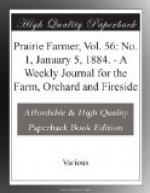* * * * *
HORTICULTURAL
Horticulturists, Write for Your Paper.
ILLINOIS HORTICULTURAL SOCIETY.
The ad-interim committee of the Illinois State Horticultural Society for the northern part of the State reported through Mr. O.W. Barnard and Arthur Bryant, Jr. Mr. Barnard had found the orchards thrifty and healthy. The yield of apples had not been large this season, but orchardists generally felt encouraged in regard to the future of their orchards. He had found the high clay soils preferable for the apple. Mr. Bryant reported the apple crop small. Some orchards had borne good crops, especially of the Ben Davis. In others, this variety had failed.
ORCHARD CULTURE.
Mr. W.T. Nelson, of the committee on orchard culture, recommended the planting of orchards on high, sloping ground. In the rather low and level country in which he lived (Will county) orchard trees lasted but fifteen or twenty years. But few varieties seem to do well in any locality. He would advise men about to set out orchards to ascertain what varieties do well in their particular locality, and then plant no others. He would not prune young orchards. He recommended the tiling of orchards.
HIGH OR LOW, LAND.
Mr. Nelson’s report opened up the subject of high or low lands for orchards. Mr. Robinson got more apples from trees on low lands than from elevated sites. Prof. Budd did not commit himself to either theory, but remarked that some varieties do best on low lands, while others preferred the higher situations. Parker Earle thought that this theory of low lands for our apple orchards was contrary to the past teachings of the society. In his opinion high grounds are preferable. The subject was a complicated one for Prof. Burrill. He had seen many low ground orchards that bore good crops this year. There are many modifications that effect the crop. It is not merely the elevation of orchard sites. It was his belief that high ground, all things considered, is the best. Mr. Robinson was not enthusiastic about the tile drainage of orchards. Our trees need more water than they usually get. They do not suffer from too much water, but from dry summers and rolling land. Mr. Spalding, of Sangamon county, had found his nursery trees poorest when planted on a depressed surface. He tiled extensively. His subsoil was a clay loam. Nine years ago he laid tile 3-1/2 feet deep and 30 feet apart. He did not believe in manuring young trees. Too rapid growth is not wanted. Trees in Illinois grow as much in one year as they do in two years in the State of New York, where they raise more fruit than we do. The most rapid growing trees are the tenderest. He does not force the




